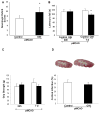Obesity and hyperglycemia lead to impaired post-ischemic recovery after permanent ischemia in mice
- PMID: 26694743
- PMCID: PMC4731242
- DOI: 10.1002/oby.21388
Obesity and hyperglycemia lead to impaired post-ischemic recovery after permanent ischemia in mice
Abstract
Objective: Obesity-induced diabetes has increased over the years and has become one of the risk factors for stroke. We investigated the influence of diet-induced obesity and hyperglycemia on permanent distal middle cerebral artery occlusion (pMCAO)-induced ischemic stroke in mice.
Methods: Male C57/Bl6 mice were treated with a high-fat/high-carbohydrate diet [HFCD/obese and hyperglycemia (O/H)] or a normal diet (control) for 3.5 months, subjected to pMCAO, and sacrificed after 7 days.
Results: Infarct volume analysis showed no differences between the O/H and control group, whereas neurological deficits were significantly higher in the O/H group compared to the control group. Sirtuin (Sirt1) was overexpressed and NADPH oxidase was reduced in the O/H group. O/H mice had significantly lower expression of Wnt and glycogen synthase kinase 3 α and β, a key component in the Wnt signaling pathway. Translocation of apoptosis inducing factor (AIF) to the nucleus was observed in both the O/H and control groups, but O/H mice showed a higher expression of AIF in the nucleus.
Conclusions: These data suggest that impaired Wnt signaling and active apoptosis result in reduced post-stroke recovery in obese and hyperglycemic mice.
© 2015 The Obesity Society.
Conflict of interest statement
Figures





Similar articles
-
Hyperbaric Oxygen Reduces Infarction Volume and Hemorrhagic Transformation Through ATP/NAD+/Sirt1 Pathway in Hyperglycemic Middle Cerebral Artery Occlusion Rats.Stroke. 2017 Jun;48(6):1655-1664. doi: 10.1161/STROKEAHA.116.015753. Epub 2017 May 11. Stroke. 2017. PMID: 28495827 Free PMC article.
-
Infiltration of invariant natural killer T cells occur and accelerate brain infarction in permanent ischemic stroke in mice.Neurosci Lett. 2016 Oct 28;633:62-68. doi: 10.1016/j.neulet.2016.09.010. Epub 2016 Sep 13. Neurosci Lett. 2016. PMID: 27637387
-
Beneficial potential of intravenously administered IL-6 in improving outcome after murine experimental stroke.Brain Behav Immun. 2017 Oct;65:296-311. doi: 10.1016/j.bbi.2017.05.019. Epub 2017 Jun 3. Brain Behav Immun. 2017. PMID: 28587928
-
Activation of cerebral sodium-glucose transporter type 1 function mediated by post-ischemic hyperglycemia exacerbates the development of cerebral ischemia.Neuroscience. 2015 Dec 3;310:674-85. doi: 10.1016/j.neuroscience.2015.10.005. Epub 2015 Oct 8. Neuroscience. 2015. PMID: 26454021
-
Ruscogenin reduces cerebral ischemic injury via NF-κB-mediated inflammatory pathway in the mouse model of experimental stroke.Eur J Pharmacol. 2013 Aug 15;714(1-3):303-11. doi: 10.1016/j.ejphar.2013.07.036. Epub 2013 Jul 30. Eur J Pharmacol. 2013. PMID: 23911884
Cited by
-
Erythropoietin and mTOR: A "One-Two Punch" for Aging-Related Disorders Accompanied by Enhanced Life Expectancy.Curr Neurovasc Res. 2016;13(4):329-340. doi: 10.2174/1567202613666160729164900. Curr Neurovasc Res. 2016. PMID: 27488211 Free PMC article. Review.
-
Nicotinamide as a Foundation for Treating Neurodegenerative Disease and Metabolic Disorders.Curr Neurovasc Res. 2021;18(1):134-149. doi: 10.2174/1567202617999210104220334. Curr Neurovasc Res. 2021. PMID: 33397266 Free PMC article. Review.
-
Effect of metabolic disorders on reactive gliosis and glial scarring at the early subacute phase of stroke in a mouse model of diabetes and obesity.IBRO Neurosci Rep. 2024 Dec 4;18:16-30. doi: 10.1016/j.ibneur.2024.12.002. eCollection 2025 Jun. IBRO Neurosci Rep. 2024. PMID: 39816479 Free PMC article.
-
Analysis of Research Directions on the Rehabilitation of Patients with Stroke and Diabetes Using Scientometric Methods.Healthcare (Basel). 2022 Apr 21;10(5):773. doi: 10.3390/healthcare10050773. Healthcare (Basel). 2022. PMID: 35627909 Free PMC article. Review.
-
The Stroke-Induced Increase of Somatostatin-Expressing Neurons is Inhibited by Diabetes: A Potential Mechanism at the Basis of Impaired Stroke Recovery.Cell Mol Neurobiol. 2021 Apr;41(3):591-603. doi: 10.1007/s10571-020-00874-7. Epub 2020 May 23. Cell Mol Neurobiol. 2021. PMID: 32447613 Free PMC article.
References
-
- Hubert HB, Feinleib M, McNamara PM, Castelli WP. Obesity as an independent risk factor for cardiovascular disease: a 26-year follow-up of participants in the Framingham Heart Study. Circulation. 1983;67:968–977. - PubMed
-
- George MG, Tong X, Kuklina EV, Labarthe DR. Trends in stroke hospitalizations and associated risk factors among children and young adults, 1995–2008. Annals of neurology. 2011;70:713–721. - PubMed
-
- Park HR, Park M, Choi J, Park KY, Chung HY, Lee J. A high-fat diet impairs neurogenesis: involvement of lipid peroxidation and brain-derived neurotrophic factor. Neuroscience letters. 2010;482:235–239. - PubMed
-
- Sarikaya H, Arnold M, Engelter ST, Lyrer PA, Mattle HP, Michel P, et al. Outcome of intravenous thrombolysis in stroke patients weighing over 100 kg. Cerebrovascular diseases. 2011;32:201–206. - PubMed
Publication types
MeSH terms
Substances
Grants and funding
LinkOut - more resources
Full Text Sources
Other Literature Sources
Medical

